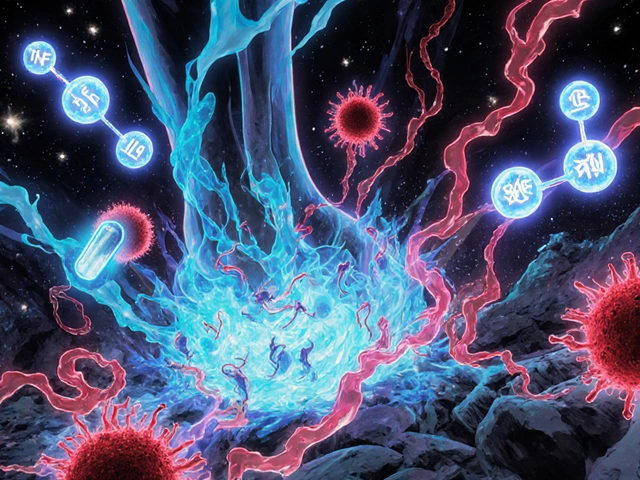Most people think color blindness means seeing the world in black and white. But for the vast majority of those affected, it’s not about missing color entirely-it’s about mixing them up. Specifically, red-green color blindness is the most common form, affecting about 8% of men and 0.5% of women worldwide. It’s not a disease. It’s not something you develop over time. It’s something you’re born with-and it’s passed down through your genes, mostly from mom to son.
How Your Eyes See Color (And What Goes Wrong)
Your eyes have three types of cone cells that detect color: one for red, one for green, and one for blue. These cones contain light-sensitive proteins called photopsins. When light hits them, they send signals to your brain, which pieces together the colors you see. In red-green color blindness, something goes wrong with the red or green photopsins. The genes that make these proteins sit on the X chromosome, which is why this condition hits men harder.Men have one X and one Y chromosome. If the X they get from their mom carries a faulty red or green gene, they’ll have color blindness. Women have two X chromosomes. They’d need two faulty copies-one from each parent-to be affected. That’s why it’s so much rarer in women. Even then, some women with one faulty gene may still notice subtle differences in color, thanks to how their bodies randomly silence one X chromosome in each cell.
The Two Main Types: Protanopia and Deuteranopia
There are two major forms of red-green color blindness, both caused by missing or broken photopsins:- Protanopia: The red photopsin is missing or non-functional. Reds appear darker, almost black. Reds and greens look very similar, and some shades of orange and brown get confused with gray.
- Deuteranopia: The green photopsin is missing. Greens look more like beige or tan, and reds appear duller. This is the most common type.
There are also milder versions: protanomaly (reduced red sensitivity) and deuteranomaly (reduced green sensitivity). Deuteranomaly alone affects about 5% of men. People with these forms can still see most colors but struggle to tell apart shades that look identical to them-like a dark red traffic light versus a dim green one.
Why It’s Inherited This Way
The genes for red and green photopsins sit right next to each other on the X chromosome. They’re so close, they often get mixed up during sperm production. That’s called unequal recombination. Sometimes, a gene copy gets deleted. Other times, a red gene turns into a green one-or vice versa-by accident. This is why the same family can have different types of color blindness across generations.Here’s how it plays out in real life:
- A mother who carries the faulty gene (but isn’t color blind herself) has a 50% chance of passing it to her son. If he gets it, he’ll be color blind.
- If she passes it to her daughter, the daughter will be a carrier-like her mom-unless the father is also color blind.
- A color blind father can’t pass the condition to his sons (he gives them his Y chromosome), but all his daughters will inherit his faulty X and become carriers.
This is why you’ll often see color blindness skip a generation. A grandfather passes it to his daughter (who doesn’t show symptoms), and she passes it to her son.

How It’s Diagnosed
The most famous test is the Ishihara test. It uses colored dots to form numbers. People with normal color vision see a 5 or a 2. Someone with red-green color blindness might see nothing-or a different number. It’s simple, fast, and still used in schools, military screenings, and driver’s license offices.But the Ishihara test isn’t perfect. Some people pass it but still struggle with color in daily life. That’s why newer tests, like the Farnsworth-Munsell 100 Hue Test or digital tools like Color Oracle, give a fuller picture. These tools show how colors look to someone with specific types of color blindness, helping doctors and designers understand the real-world impact.
What It Actually Feels Like
If you’ve never experienced it, it’s hard to imagine. It’s not like watching a black-and-white movie. It’s more like being told, “This red shirt looks great with those green pants,” while you see both as muddy brown. You learn to adapt. You rely on brightness, texture, or labels.One engineer in Bristol told me he once almost wired a circuit board backwards because the red and green wires looked identical. He now labels every wire with a number. A pilot applicant in the U.S. was turned away from flight school because he couldn’t pass the color test-even though his vision was 20/20. He’s not blind. He just can’t tell red from green at 30,000 feet.
And it’s not just work. A 2022 survey of over 1,200 people with red-green color blindness found that 78% struggled with color-coded school materials. 65% had trouble with traffic lights in fog. 42% couldn’t tell if their phone charger was plugged in because the indicator light was red.
Tools That Help
There’s no cure. But there are tools that make life easier.- EnChroma glasses: These tinted lenses cost between $330 and $500. They don’t restore normal color vision, but for about 80% of users, they make reds and greens feel more distinct. They’re not magic-they don’t work for everyone, especially those with complete absence of a photopsin.
- Digital filters: Apple and Windows both have built-in color filters. Turn them on, and your screen shifts colors to make reds and greens pop. Around 0.8% of iPhone users have them enabled-most of them don’t even know they have color blindness.
- ColorADD: A universal symbol system developed in Portugal. A triangle means red. A circle means green. It’s now used on public transit maps in 17 countries.
- Colorblindifier: A free Photoshop plugin used by over 45,000 designers. It lets them see their work through the eyes of someone with color blindness before they publish it.
Web designers now follow WCAG guidelines that require color contrast ratios and non-color-dependent cues. That means charts must use patterns, not just colors. Buttons must have labels, not just red/green indicators.
It’s Not Just About Seeing Red and Green
People with red-green color blindness often don’t realize they’re different until they’re tested. Many grow up thinking everyone sees the world the way they do. They might think their mom’s “purple” scarf is actually blue. Or that the grass looks slightly off in autumn.But here’s the thing: most people with this condition don’t see it as a disability. A 2022 survey found that 92% of those affected consider it a minor inconvenience. They’ve learned to live with it. Some even say it makes them better designers, better problem-solvers, because they rely on other cues.
Still, there’s stigma. 37% of respondents said they’ve been embarrassed when they mismatched clothes or didn’t notice a red warning light. That’s why awareness matters. It’s not about pity. It’s about understanding.
What’s Next? Science and Hope
In 2022, scientists at the University of Washington used gene therapy to restore full color vision in adult squirrel monkeys with red-green color blindness. The effect lasted over two years. It’s not ready for humans yet-but it’s proof that the brain can learn to see new colors, even as an adult.The National Eye Institute is funding research to develop similar therapies for people. Meanwhile, companies like EnChroma are improving their lenses. Their new CXA technology, launched in 2023, boosts color discrimination by 30% compared to older models.
In the UK, the Equality Act 2010 recognizes color blindness as a disability that requires reasonable accommodations. Employers must make adjustments-like labeling wires, using patterns instead of color codes, or offering screen filters.
It’s not about fixing people. It’s about fixing the world around them.
What You Can Do
If you’re a parent and suspect your child might be color blind-especially if there’s a family history-get them tested early. It’s not urgent, but it helps teachers adapt lessons. If you’re a designer, use tools like Color Oracle or Colorblindifier before publishing. If you’re a teacher, add patterns to your charts. If you’re an employer, ask employees if they need adjustments.And if you think you might be color blind? Take a free online test. Don’t wait for someone else to notice. You might be surprised what you’ve been missing.






